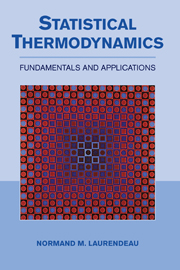Book contents
- Frontmatter
- Contents
- Preface
- 1 Introduction
- PART ONE FUNDAMENTALS OF STATISTICAL THERMODYNAMICS
- PART TWO QUANTUM MECHANICS AND SPECTROSCOPY
- PART THREE STATISTICAL THERMODYNAMICS IN THE DILUTE LIMIT
- PART FOUR STATISTICAL THERMODYNAMICS BEYOND THE DILUTE LIMIT
- 12 Thermodynamics and Information
- 13 Elements of the Solid State
- 14 Equilibrium Radiation
- Problem Set VI The Solid State and Radiation (Chapters 13–14)
- PART FIVE NONEQUILIBRIUM STATISTICAL THERMODYNAMICS
- PART SIX THE ENSEMBLE METHOD OF STATISTICAL THERMODYNAMICS
- PART SEVEN APPENDICES
- Index
14 - Equilibrium Radiation
Published online by Cambridge University Press: 05 June 2012
- Frontmatter
- Contents
- Preface
- 1 Introduction
- PART ONE FUNDAMENTALS OF STATISTICAL THERMODYNAMICS
- PART TWO QUANTUM MECHANICS AND SPECTROSCOPY
- PART THREE STATISTICAL THERMODYNAMICS IN THE DILUTE LIMIT
- PART FOUR STATISTICAL THERMODYNAMICS BEYOND THE DILUTE LIMIT
- 12 Thermodynamics and Information
- 13 Elements of the Solid State
- 14 Equilibrium Radiation
- Problem Set VI The Solid State and Radiation (Chapters 13–14)
- PART FIVE NONEQUILIBRIUM STATISTICAL THERMODYNAMICS
- PART SIX THE ENSEMBLE METHOD OF STATISTICAL THERMODYNAMICS
- PART SEVEN APPENDICES
- Index
Summary
In this chapter, we examine equilibrium radiation, which represents our third and final application of statistical mechanics to independent particles beyond the dilute limit. For simplicity in mathematically modeling the radiant field, we apply the methods of statistical thermodynamics to electromagnetic waves enclosed in a cubical blackbody cavity. The enclosed radiation is at both thermal and radiative equilibrium if the walls of the cavity are at constant temperature with equal rates of emission and absorption, respectively.
Bose–Einstein Statistics for the Photon Gas
From a quantum perspective, the electromagnetic radiation within a blackbody cavity can be modeled as an assembly of independent photons. Given this representation, we recall from Section 5.9 that photons are particles of zero spin; hence, a photon gas must follow Bose–Einstein statistics, whose equilibrium particle distribution, following Eq. (3.31), is normally given by
However, in comparison to the usual assumptions associated with Eq. (14.1), photons do not obey particle conservation as they are constantly being formed and destroyed at the walls of a blackbody cavity. Of course, thermodynamic equilibrium still mandates conservation of energy at these same walls. As a result, nothing prevents, for example, the replacement of one incoming photon with two outgoing photons, each having half its energy.
- Type
- Chapter
- Information
- Statistical ThermodynamicsFundamentals and Applications, pp. 275 - 282Publisher: Cambridge University PressPrint publication year: 2005



